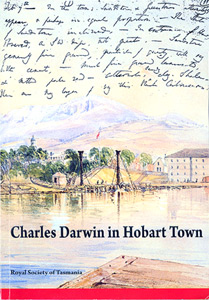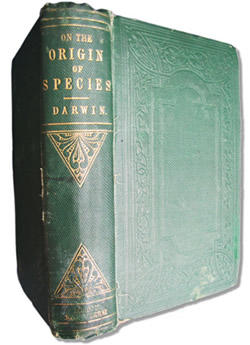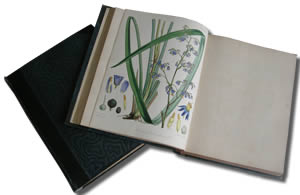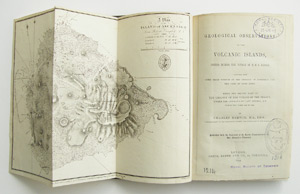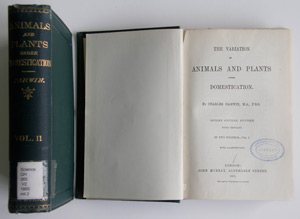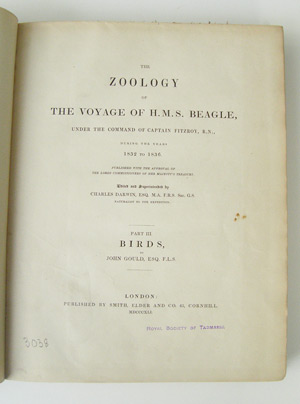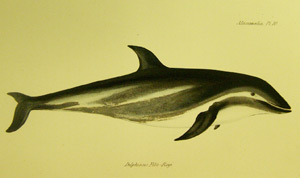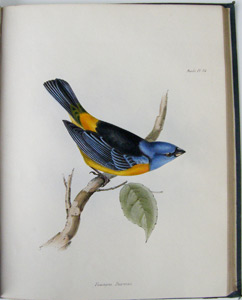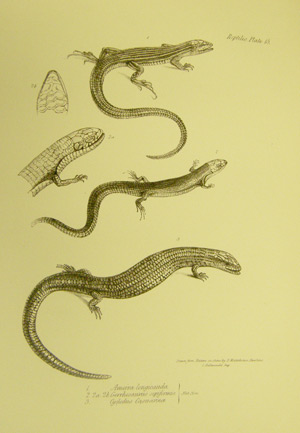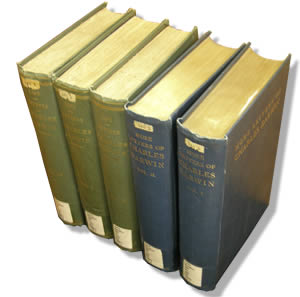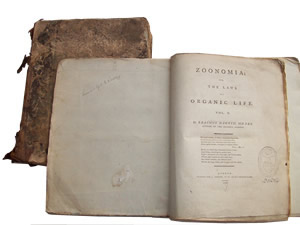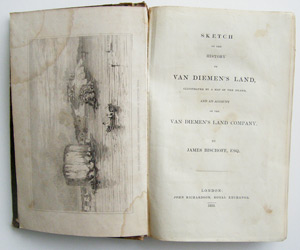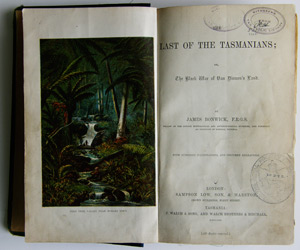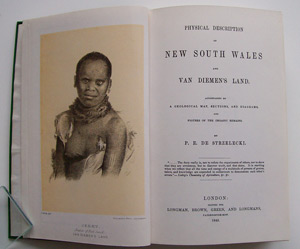
|
Royal Society of Tasmania, Charles Darwin in Hobart Town, edited by Margaret Davies, Hobart, Royal Society of Tasmania, 2009.
Links to the writings of Charles Darwin: The Complete Work of Darwin Online The Darwin Correspondence Project Books from the University of Tasmania Library Special Collections:Darwin, C. 1859: On the Origin of Species by means of Natural Selection, or, The preservation of favoured races in the struggle for life John Murray, London.
Darwin, C. 1901: On the Origin of Species by means of Natural Selection John Murray, London. Copy owned by Hermann Ritz 1902. Hermann Ritz taught modern languages at the University of Tasmania from 1900 until his death in 1916. In 1904 he published An Essay on the Evolution of Words.Its preface remarked that whereas ‘some of the greatest minds’ had sought to explain evolutionary process in nature, other areas lacked such study. Philology was notably deficient and it was ‘the purpose of this essay to present some suggestions on this subject’. A similar paper addressed The Psychology of Language. Ritz applied his theories to the language of the Tasmanian Aboriginals, hoping to ‘have found the way that will, in time and after arduous and sympathetic efforts, enable us to hear once more “The sound of a voice that is still”.’ Hooker, J. D. 1860: The Botany of the Antarctic Voyage of H.M. Discovery Ships Erebus and Terror III. Flora Tasmaniae Lovell Reeve, London Hooker’s work was published just a few weeks after On the Origin of Species and its support of Darwinian ideas did much to further their acceptance.
Darwin, C. 1844: Geological Observations on the Volcanic Islands, visited during the voyage of H.M.S. Beagle, Smith Elder, London
Darwin, C. 1874: The Descent of Man and Selection in Relation to Sex John Murray, London Darwin, C. 1905: The Variation of Animals and Plants under Domestication, John Murray, London. 2 v. Correspondence with Mr. B. O’Neile Wilson from Tasmania regarding cattle crosses and their fertility (p. 102). This followed on from Wilson’s response to On the Origin of Species where he applauded Darwin’s remarks on the variation of instinct in domestic animals.
Darwin C. 1840: Zoology of the Voyage of H.M.S. Beagle under the command of Captain FitzRoy, R.N. during the years 1832 to 1836
Part 1 Fossil Mammalia by Richard Owen
Delphinus FitzRoyi Part 111 Birds by John Gould
Part V Reptiles by Thomas Bell
Darwin, C. 1887: The Life and Letters of Charles Darwin John Murray, London 3 v. Darwin C. 1903: More Letters of Charles Darwin John Murray, London 2 v. Darwin, Erasmus 1796: Zoonomia Printed for J. Johnson, London.
The most remarkable element of the book is not Darwin’s system of classification … or its medical content, but is his speculations on evolution. In a chapter entitled “Of Generation” he speculates that all warm-blooded animals may have arisen from “one living filament”, which: Bibliography of works related to the UTAS Library exhibition: BACKHOUSE, J., 1838: Extracts from the Letters of James Backhouse. Third part. Harvey and Dalton, London. BISCHOFF, J., 1832: Sketch of the History of Van Diemen’s Land. John Richardson, London. BONWICK, J., 1870: The Last of the Tasmanians. Sampson Low, London. BRITISH MUSEUM, 1909: Memorials of Charles Darwin. British Museum, London. The commentary suggests that Darwin simplified/exaggerated the similarities. BURNS, T.E. and SKEMP, J.R., 1961: Van Diemen’s Land Correspondents … 1827-1849. Queen Victoria Museum, Launceston. BUTCHER, B.W., 1989: … Charles Darwin’s Use of Australian Resources, 1837-1882. Historical Records of Australian Science 8: 1-14. BUTCHER, B.W., 1994: Darwin, Darwinism, and the Australian Aborigines, in R. McLeod and P.E. Rehbock (Eds): Darwin’s Laboratory. University of Hawaii, Honolulu: 371-94. My thinking is close to Butcher’s; happily my own earlier work was of some (small) help to him. DARWIN, C., 1839: Journal and Remarks, 1832-1836. This was volume 3 of the Narrative of the Surveying Voyages of His Majesty’s Ships Adventure and Beagle. Henry Colburn, London. The major Tasmanian references are at 532-6. DARWIN, C., 1844: Geological Observations on the Volcanic Islands visited during the Voyage of H.M.S. Beagle. Smith Elder, London. DARWIN, C., 1859: On the Origin of Species by Means of Natural Selection. John Murray, London. DARWIN, C., 1868: The Variation of Animals and Plants under Domestication. John Murray, London. 2 vols. This (the first) edition seen only on the internet at darwin-online.org.uk DARWIN, C., 1872. On the Origin of Species by Means of Natural Selection. John Murray London. This (the sixth) edition also seen only at darwin-online.org.uk DARWIN, C., 1882: The Descent of Man and Selection in relation to Sex.John Murray, London. This (the second) edition also seen only at darwin-online.org.uk DARWIN, C., 1958: The Autobiography of Charles Darwin (N. Barlow, Ed). Collins, London. DARWIN, C., 1988: Charles Darwin’s Beagle Diary (R.D.W. Keynes, Ed). Cambridge University Press, Cambridge. The major Tasmanian references are at pages 408-10. DARWINCORRESPONDENCE PROJECT. This massive enterprise is in process of hard-copy publication, but easier availability is at the internet site darwinproject.ac.uk DAVIS, P., 2004: Thompson, John Vaughan (1779-1847). Oxford Dictionary of National Biography 34: 453-4. DE STRZELECKI, P.E., 1845: Physical Description of New South Wales and Van Diemen’s Land. Longmans Brown Green, London. HOOKER, J.D., 1860. The Botany of the Antarctic Voyage of H.M. Discovery Ships Erebus and Terror … . Part III, Flora Tasmaniae. Lovell Reeve, London. NEWSPAPERS, 1836: Hobart Town Courier, 5 February (science and learning), 12 February (survey), 19 February (collections and Backhouse); Colonial Times, 9 February (arrival); True Colonist, 12 February (survey); Bent’s News, 5 March (chronometry); Tasmanian and Review, 1 April (terrestrial position). Peter Stephenson, Hobart, currently is studying the matters of chronometry and location. NICHOLAS, F.W. and M., 1989: Charles Darwin in Australia. Cambridge University Press, Cambridge. ROE, M., 1984: Nine Australian Progressives. University of Queensland Press, Brisbane. ROE, M., 1986: Darwin in Hobart, 1836. Island 28: 16-8. SHINE, R. and HUTCHINSON, M., 1991: Charles Darwin in Tasmania. Australian Natural History 23: 794-801. VON MUELLER, F., 1998: Regardfully Yours … Selected Correspondence (R.W. Home et al., Eds). Volume One. Peter Lang, Bern. |
|||||||||||||||
Charles Darwin Home | Utas Library Home Authorised by the University Librarian | © University of Tasmania ABN 30 764 374 782 |
